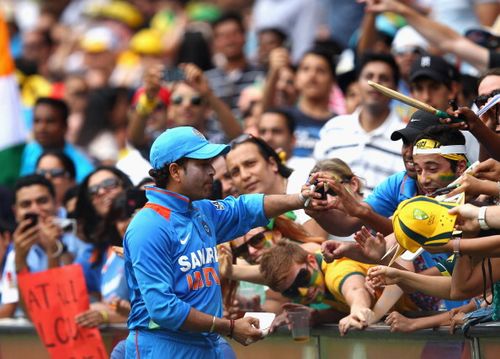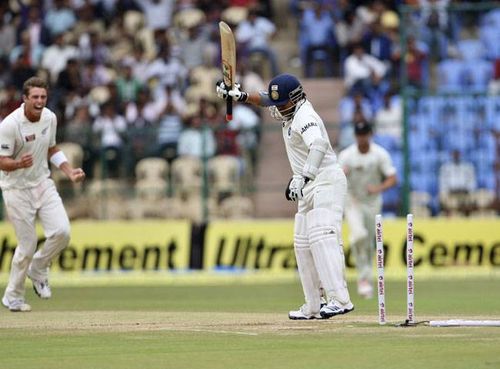
Sachin Tendulkar: The boy who survived

For any youngster making his debut in international cricket, the task is very simple. You either pocket in some runs or scalp wickets and make an early impact for a promising future or see yourself tear apart and see yourself grow old dying for another opportunity. But such a scenario was never presented to one young lad. This young boy was drawn in the playing eleven for his prodigal start and a stunning debut first class season just at the age of 16. As he took guard before the bowling stalwarts from Pakistan, namely Imran Khan, Wasim Akram, Waqar Younis (who also was making his debut), sudden death was inevitable. But still this boy survived for 28 minutes and accepted death with grace by telling himself ”Welcome to Test Cricket”.
Since then, Sachin Tendulkar has emerged as a complete batsman in the modern era. But even with such a prolific career, he has had to face numerous biased criticisms, baseless rumors, pessimistic writers, 24X7 media attention. He is at the epicenter with galactic stars attracted and revolving around him. Despite some realistic checks for his criticism which I will be discussing in my next post, other critique writers want to establish their uniqueness by just pushing themselves to go against him. It is the urgency of them wanting to get noticed than their reasons that drives them to such limits.
We have heard all of them so many times. “He is not a match winner. He is becoming old. He fails at critical moments.” But soon those readings are diminished with a headline “Sachin Tendulkar answers his critics”. Both of these events happen like a routine clockwork for an Indian cricket fan. As a neutral, I can easily see the two extremes and clearly you cannot expect Sachin to carry the bat every innings, or make him drink from the fountain of youth. His failures at critical moments must be seen with inner depth. When the public discovers a superstar who is exceptional, their expectations keeps growing and is at its peak when the situation is highly demanding. Such situations are remembered more by the human brain and clearly, with a 22 year old career, such situations are plenty in number. Failures at such stages have set a benchmark when it repeated not 10 or 20 times, but even just as small as say, twice.
Leaving those unfair scorchers behind, there is a serious analysis of problems that today’s Sachin faces. One big issue is his lack of regular cricket practice. He does not play ODI cricket at all in the name of rest. At 29, he could return back to cricket after months and still wave his magic with his bat but at 39 today, the usual beauties like “the flick of the wrists and way she goes, leaning towards the ball, a perfect pull against a well pitched short ball, soft hands, bottom hands, leg glances, textbook cover drives, pure class and timing, straight as a dye” cannot be produced every time. It can be delivered only in short bursts and every next ball after such a delight follows the slightest vulnerability, which sees our hero head back to the pavilion with his head down.
The midas touch and magic is in his blood, with his heart pumping every time to produce the flamboyance. But either his feet won’t get moving or there is a tiny little gap between bat and pad or a momentary lapse of concentration. The front foot moves a little forward or the adjustment is a fraction late. This gives chances to the bowler and the shutter takes a long time to close before an opponent can penetrate.
It is sad to see that today many Indian fans see cricket through the eyes of media more than by watching just pure cricketing action. That is why they have the urge for the transition of Indian cricket team to happen very soon and since Sachin is the oldest member, he is treated even poorly. I have seen the look on Sachin’s face when he was given out when Gillespie’s ball struck his shoulder and Bucknor raised his finger. Or when he was run out after his collision with Akhtar or when he has been rattled on numerous occasions in the nervous 90’s or even when he scored a duck after his stump was uprooted in the losing match against Sri Lanka in the 2007 World Cup. And in all those occasions, he would simply walk off as if he deserved that but never ever have I seen such a reaction after he was bowled for the third time in the recently concluded series against New Zealand.

He knows what forced Dravid and Laxman to retire and his mind will not be foolish enough to believe it was their call or inner voices. Kohli and Pujara’s success have stamped hope on people that these old lads must walk off and the team will find a suitable replacement. But the remarkable truth is that nobody can be another Dravid or Laxman. If today’s successors have stayed long, they have only made a name for themselves and not filled in the shoes of their legendary predecessors.
Since his debut, it has been a long journey with lots of battles, glory, fame, criticism, respect. One might wonder how he survived and is still waging war in the battlefield. Just as his debut was a classic so were his challenges. They were historical battles against the best there has ever been after him. Sachin has seen a generation of bowlers from Imran Khan, Wasim Akram, Waqar Younis, Shane Warne, Ambrose, Walsh, McGrath, Donald, Murali,Pollock, Brett Lee, Akthar, Steyn. Those giant names would agree with Mark Waugh’s comment that “We did not lose to a team called India, but to a man called Sachin”. He is very unique in nature and so is his cricketing career.
“The joy he brings to the millions of his countrymen, the grace with which he handles all the adulation and the expectations and his innate humility – all make for a one-in-a-billion individual.”
-Glenn McGrath